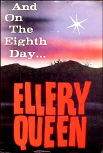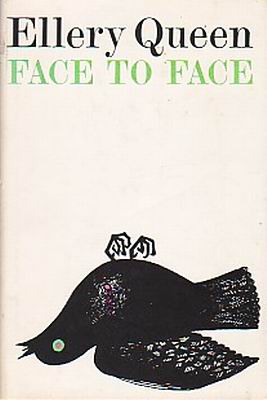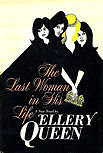
 |


|
TO PAGES: 1 • 2 • 3 • 4 • 5 • 6 • 7 • 8 • 9 • 10 • 11 • 12 • 13 |
|
Ellery Queen Easter Eggs
|
||
|
|
||
|
Why would these two Jewish cousins begin hiding references to the holiday Easter in their works? I asked that very question of Richard Dannay, Frederic’s son, at the 2005 Ellery Queen centenary symposium hosted by EQMM in New York City. Richard’s answer was “I have absolutely no idea.” Whatever the reason for the inclusion of these Easter references, their repeated presence in the Queen canon is undeniable. |
||
|
|
||
|
Four years later,
in Calamity Town,
published in 1942, the first
Ellery Queen
mystery to be set in the
Queen-created upper New York
town of Wrightsville, a
culminating episode occurs in
chapter 27, which is titled
“Easter Sunday: Nora’s Gift.”
Interesting, but still, we could
be dealing with coincidence. In 1950 another Wrightsville mystery was published, Double, Double. The chapters in Double, Double are all titled with dates, beginning with April 4, and culminating events occur in the chapter entitled “Weekend, April 8-9.” In 1950 that weekend was Easter. Dannay and Lee likely intended the Queen saga to end with the publication of The Finishing Stroke in 1958. Easter did not figure into that story, which instead focused on Christmas week. The story also references an important event that occurred on January 11, 1905 -- the date on which Manfred Lee was born. |
||
 But by 1963 Ellery arose from his literary death with the publication of The Player on the Other Side, and the Easter game was again afoot. During the course of Player we learn that a central character was born on the 20th of April, 1924. You guessed it – Easter. |
||
That particular date is cloaked in at least two other obscurities. First,
exactly thirty-five years before, on April 20, 1889, Hitler was born. Beginning
with that reference in 1963 the works of Queen occasionally combine references
to Hitler in tandem with Easter. But second, in the circle of the year April 20
is precisely one half of a year separated from October 20, the day on which
Frederic Dannay was born in 1905. So just as
The Finishing Stroke
references Lee’s birthday on January 11, so to,
The Player on the Other Side
references, albeit more obscurely, Dannay’s birthday, and does so by tying the
date to Easter. Were
there to be any doubt as to the recurrent Easter themes (as well as references
to Hitler) in the works of Dannay and Lee, those doubts would be dispelled by
And on the Eighth Day,
published in 1964. While this mystery is one of my favorites, many Queen fans
do not like it at all. The book is unlike any other Queen novel, much more of
an allegory -- an Easter
allegory -- than a mystery. Although written in 1964,
And on the Eighth Day
recounts Ellery’s visit to a hidden southwest religious community twenty years
earlier, in 1944. As was the case in Double
Double, the chapter headings in
Eighth Day are dates,
beginning with April 2 and ending, on April 9. You guessed it – in 1944 this
was Easter week. Moreover, the story revolves around a book, thought to be a
recovered religious tract long lost by the community, that had been
re-discovered and purchased by the leader of the community on April 8, 1939 –
yet another Easter. Were
there to be any doubt as to the recurrent Easter themes (as well as references
to Hitler) in the works of Dannay and Lee, those doubts would be dispelled by
And on the Eighth Day,
published in 1964. While this mystery is one of my favorites, many Queen fans
do not like it at all. The book is unlike any other Queen novel, much more of
an allegory -- an Easter
allegory -- than a mystery. Although written in 1964,
And on the Eighth Day
recounts Ellery’s visit to a hidden southwest religious community twenty years
earlier, in 1944. As was the case in Double
Double, the chapter headings in
Eighth Day are dates,
beginning with April 2 and ending, on April 9. You guessed it – in 1944 this
was Easter week. Moreover, the story revolves around a book, thought to be a
recovered religious tract long lost by the community, that had been
re-discovered and purchased by the leader of the community on April 8, 1939 –
yet another Easter. |
||
|
One of the
strangest aspects of
And on the Eighth
Day
is the fact that there are many “clues” in the book that are never in fact dealt
with or even addressed during the narrative. These include a very significant
(and Easter-related) anagram, which (because I hate spoilers) I will leave
unexplained, just as Ellery did. And what does the title of the mystery itself mean? An obvious answer is the fact that the story unfolds over an eight day period. But, as always with Queen, there is more to it than that. The book of Luke, 1:59, suggests that the Eighth Day was the “naming day,” or day of circumcision for Jesus. (“And on the eighth day they came to circumcise the child. And they would have called him Zechariah after his father.”) Readers of And on the Eighth Day will note that there is, indeed, a naming of sorts on the eighth day of the narrative. There are also repeated and unexplained references to the number “50,” in And on the Eighth Day – as an example, the number “50” appears on the buttons of the leader of the community’s robe. While the significance of this is never explained by Queen (the authors) or Queen (the detective), there is one, and only one, book in the Bible containing precisely 50 chapters – the Book of Genesis; the book that begins with a recounting of what transpired beginning "on the first day.” Finally, and I think most intriguing, is the fact that the Jewish “Eighth Day” holiday is Shemini Atzeret, a holiday that occurs on the eighth day of the Festival of Sukkot. And why is that interesting? In 1905 Sukkot began at sundown on October 20 – the day that Frederic Dannay was born. So which of the foregoing oddities explains the title of the mystery? My bet, knowing Ellery Queen, is “all of the above.” |
||
 From
the obvious Easter motifs in
And on
the Eighth Day
Queen brings us back to Easter
by way of obscurity. In
Face to Face,
published in 1967, there is
absolutely no reference to
Easter. However, near the end
of the mystery Ellery is called
upon to help find someone to
officiate at a wedding, that,
contrary to Christian tradition,
is planned for Palm Sunday.
Face to
Face
concludes the next day at a New
York airport. From
the obvious Easter motifs in
And on
the Eighth Day
Queen brings us back to Easter
by way of obscurity. In
Face to Face,
published in 1967, there is
absolutely no reference to
Easter. However, near the end
of the mystery Ellery is called
upon to help find someone to
officiate at a wedding, that,
contrary to Christian tradition,
is planned for Palm Sunday.
Face to
Face
concludes the next day at a New
York airport. |
||
 In
1970 – fully three years after Face to Face
– The Last Woman in his Life,
begins just minutes after Face to Face
concluded -- on the same day and at the same New York
airport. The Last Woman in his Life
also nowhere uses the word “Easter,” but if you start with the date of the Palm
Sunday wedding in Face to Face,
count the additional day in that book, which is also the day on which
The Last Woman in his Life
begins, and then calculate out the days that transpire in
Last Woman it becomes
apparent that the victim in Last Woman,
who is the son of a carpenter, was murdered on – Easter Sunday. In
1970 – fully three years after Face to Face
– The Last Woman in his Life,
begins just minutes after Face to Face
concluded -- on the same day and at the same New York
airport. The Last Woman in his Life
also nowhere uses the word “Easter,” but if you start with the date of the Palm
Sunday wedding in Face to Face,
count the additional day in that book, which is also the day on which
The Last Woman in his Life
begins, and then calculate out the days that transpire in
Last Woman it becomes
apparent that the victim in Last Woman,
who is the son of a carpenter, was murdered on – Easter Sunday. |
||
| So, there you have it. | ||
| Given all of this, Kurt and I made sure that in The Book Case, an Ellery Queen pastiche in which a 100-year-old Ellery solves one last murder, the reader could calculate from clues in the story that the murder, in fact, took place on Easter. This seemed the right thing to do. But if you asked me why it was the right thing to do, I still would have to shrug and give Richard Dannay’s answer – I have absolutely no idea! | ||
 |
||
|
Dale C. Andrews
Links to related articles
|

|
|
|
Introduction |
Floor Plan | Q.B.I. |
List of Suspects | Whodunit?
| Q.E.D. | Kill as
directed | New |
Copyright Copyright © MCMXCIX-MMXXV Ellery Queen, a website on deduction. All rights reserved. |